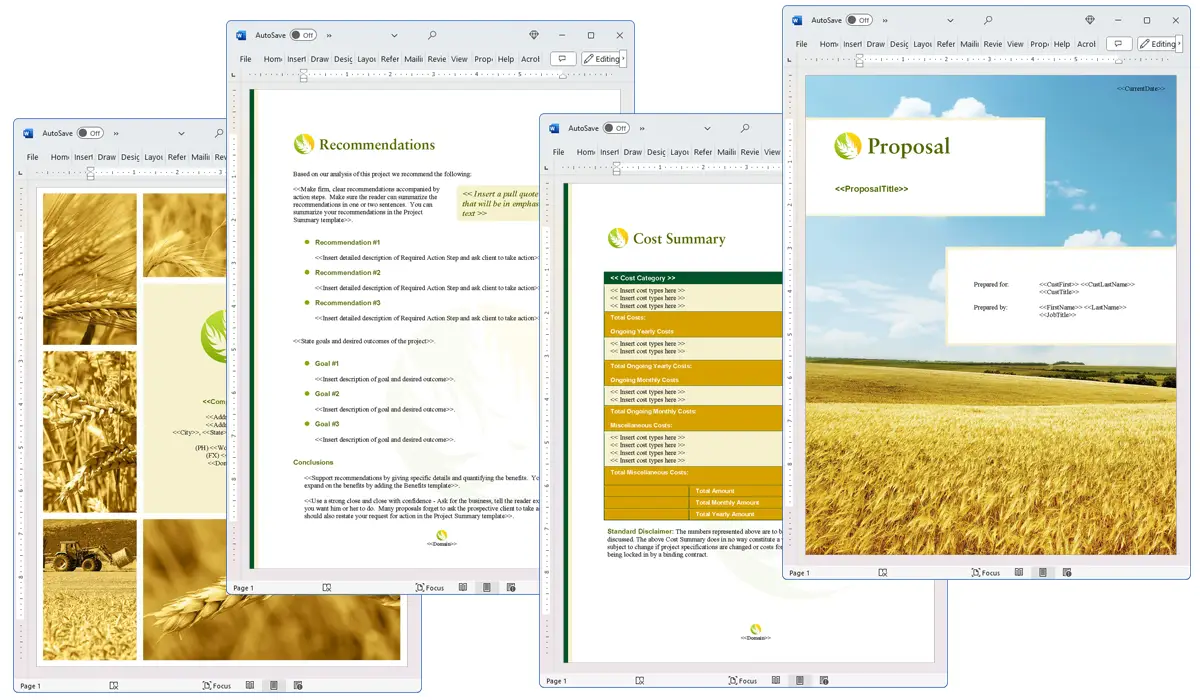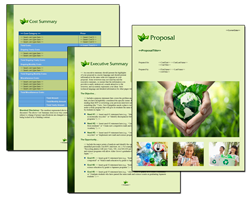What is the Requirements chapter used for?
Proposal Kit Professional Bundle adds more design themes, all six Contract Packs,
a project management library, and Expert Edition software.

Illustration of Proposal Pack Agriculture #4
We include this Requirements chapter template in every Proposal Pack, along with thousands more. You assemble this chapter with others in various combinations to create custom-tailored business proposals, plans, reports, and other documents. Proposal Packs apply custom visual designs to the templates, giving the final documents a consistent professional finish.
 DOWNLOADABLE, ONE-TIME COST, NO SUBSCRIPTION FEES
DOWNLOADABLE, ONE-TIME COST, NO SUBSCRIPTION FEES
Overview of the Requirements Chapter
When creating a business proposal, clarity and precision are paramount. The Requirements chapter plays an important role in this process. It serves to clearly outline what the client needs from a project, converting expectations and desires into a structured list of requirements. This chapter is important because it ensures that both the service provider and the client are on the same page regarding the project's scope and deliverables before any commitments are made.
How is the Requirements Chapter Used?
In a business proposal, the Requirements chapter is used to articulate the specific needs and expectations of the client. By encapsulating these details early in the proposal, it sets the stage for the rest of the document. This chapter helps in building a proposal that is tailored to meet the client's needs effectively. It acts as a reference point throughout the project lifecycle, ensuring all proposed solutions align with the stipulated requirements.
What is Included in the Requirements Chapter?
Typically, the Requirements chapter includes several key components:
- Project Scope: Defines what the project will cover and the boundaries of the work.
- Deliverables: Lists specific outcomes or products to be delivered by the end of the project.
- Deadlines and Milestones: Specifies important dates and project phases.
- Standards and Compliance: Outlines any industry-specific standards or regulatory requirements that must be met.
- Budget Constraints: Provides details on the financial limits and expectations.
Each of these elements is vital for laying down the foundation of a project that meets the client's expectations and regulatory requirements.
Use Case Examples for the Requirements Chapter
The Requirements chapter can be adapted to fit a variety of industries and needs. Here are some use case examples:
- Automation: Specifying the technical and performance standards required for a new automated assembly line.
- Manufacturing: Outlining the quality control measures and product specifications for a manufacturing contract.
- Fabrication: Detailing the material specifications and finishing standards for a custom fabrication project.
- Training: Describing the educational outcomes and resources needed for a corporate training program.
- Education: Listing the curriculum requirements and assessment methods for an educational initiative.
- Request for Proposal: Stating the specific criteria and scopes for vendors bidding on a project.
- Evaluation: Setting the benchmarks and success metrics for evaluating a pilot program.
These examples show how the Requirements chapter can be tailored to meet the unique demands of different sectors and projects.
Key Takeaways
- Central Role: The Requirements chapter is crucial for defining the scope and expectations of a project.
- Clarity and Alignment: It ensures both parties understand and agree on the project specifics from the start.
- Detail-Oriented: Includes comprehensive details such as scope, deliverables, deadlines, standards, and budget.
- Versatility: Adaptable to a wide range of industries and project types.
- Reference Point: Acts as a guideline throughout the project to keep all activities aligned with the client's needs.
Understanding and using the Requirements chapter can significantly enhance the precision and effectiveness of your business proposals.

Illustration of Proposal Pack Environmental #4
 What Our Clients Say
What Our Clients SayOriginally had little need to write proposals. But business has changed and has become more proposal-intensive. This kit has taken much work out of the writing for our employees. Thanks for making it simple!"
 4.7 stars, based on 845 reviews
4.7 stars, based on 845 reviewsAlternate Chapters
Related Chapters
Samples Using the Requirements Chapter
Document Layouts Using the Requirements Chapter
- Extensive Service Sales Proposal
- Technology Strategy Analysis
- Youth Sports Program Proposal
- Fire Alarm and Security System Installation Proposal
- Electronic Records Management Proposal
- Reserve Study
- Request for Proposal (RFP) Transportation Services
- Franchise Selling Proposal
- Financial Funding Proposal Template
- Request for Proposal (RFP)
- Request for Proposal (RFP) Equipment Supply
- Extensive Technical Proposal
- New College Curriculum Proposal
- Fire Safety Construction Proposal
- Software Licensing Sales Proposal
- Extensive Non-Technical Proposal
- New Product Idea Proposal
- Telecommunications Cellular Services Proposal
- GDPR Privacy Compliance Project Proposal
- Importing Used Farm Equipment Proposal
- And more like these

The Requirements chapter and other chapters are integrated into a Word document as illustrated here in the Proposal Pack Healthcare #4 design theme. There are hundreds of design themes available, and every design theme includes the Requirements chapter template.
A proper business proposal will include multiple chapters. This chapter is just one of many you can build into your proposal. We include the complete fill-in-the-blank template in our Proposal Pack template collections. We also include a library of sample proposals illustrating how companies in different industries, both large and small, have written proposals using our Proposal Packs. This template will show you how to write the Requirements.
We include a chapter library for you to build from based on your needs. All proposals are different and have different needs and goals. Pick the chapters from our collection and organize them as needed for your proposal.
Using the Proposal Pack template library, you can create any business proposal, report, study, plan, or document.
 Ian Lauder has been helping businesses write their proposals and contracts for two decades. Ian is the owner and founder of Proposal Kit, one of the original sources of business proposal and contract software products started in 1997.
Ian Lauder has been helping businesses write their proposals and contracts for two decades. Ian is the owner and founder of Proposal Kit, one of the original sources of business proposal and contract software products started in 1997.By Ian Lauder
 Published by Proposal Kit, Inc.
Published by Proposal Kit, Inc.


 Cart
Cart
 Facebook
Facebook YouTube
YouTube X
X Search Site
Search Site